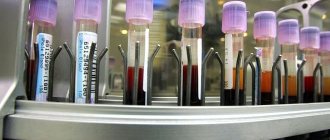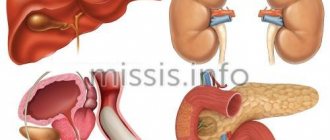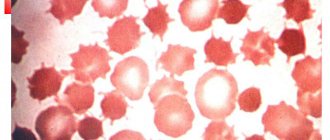Why is lupus anticoagulant dangerous?
The danger of lupus anticoagulant is that it causes antiphospholipid syndrome (APS), a condition that significantly increases the risk of blood clots.
The cause of the pathology is a failure in the immune system; one of the reasons for its occurrence may be a previous infectious-inflammatory disease. Reference! Lupus anticoagulant was so named because this substance was first discovered in patients with systemic lupus erythematosus (SLE), a severe autoimmune disease of connective tissue and small blood vessels.
Among the pressing issues of modern phlebology, one of the most attracting the attention of both researchers and practitioners is determining the cause of the development of venous thrombosis in a particular patient, assessing the risk of recurrence of venous thromboembolic complications (VTE) and the possibility of individual selection of antithrombotic therapy. The search for thrombophilias has recently become quite widespread. The most significant acquired thrombophilia is antiphospholipid syndrome.
Antiphospholipid syndrome (APS) is an autoimmune condition associated with overproduction of autoantibodies to phospholipid determinants of cell membranes, or phospholipid-binding proteins in the blood [1–4]. The development of thrombosis in this variant of thrombophilia is realized through the simultaneous activation of the procoagulant component of hemostasis (both plasma and platelet components) and the inactivation of the anticoagulant component and the fibrinolysis system, as well as additional activation of the local inflammatory response and the formation of endothelial dysfunction. The prevalence of APS in the population is still unclear: even in healthy people, up to 14% have circulating antiphospholipid antibodies [5]. Most often (up to 29-55%) antibodies to phospholipids are detected in patients with venous thrombosis with predominant localization in the deep venous bed of the lower extremities [6].
Diagnosis of APS currently requires a combination of at least one clinical and one laboratory criterion [2]:
1. Clinical
:
1.1. one or more episodes of thrombosis - venous, arterial or microvascular;
1.2. burdened obstetric history:
1.2.1. one or more episodes of unexplained loss of a morphologically normal fetus after the 10th week of gestation;
1.2.2. one or more cases of preterm delivery of a morphologically normal fetus before 34 weeks of gestation as a result of severe preeclampsia or eclampsia, severe unexplained placental insufficiency;
1.2.3. three or more unexplained obstetric losses before the 10th week of gestation.
2. Laboratory
- in two consecutive measurements with an interval of 10-12 weeks:
2.1. moderate or high level of IgG and/or IgM antibodies to cardiolipin;
2.2. moderate or high level of antibodies to β2-glycoprotein class 1 IgG and/or IgM;
2.3. positive lupus anticoagulant (LA).
To identify VA, the normalized ratio of the L1/L2 screening and confirmatory test is most often used. The L1 screening test in the presence of VA shows an increase in the patient's blood clotting time. To perform the L2 confirmatory test, phospholipids are added to the patient's plasma. An excess of phospholipids makes it possible to neutralize the effect of the patient's inhibitory autoantibodies: normalization or a decrease in the clotting time from its initial value confirms the presence of specific antiphospholipid antibodies. To simplify and standardize test results, the L1/L2 ratio is used.
Timely laboratory diagnosis of APS remains relevant in our time. A delayed start to the search for thrombophilic conditions is widespread - after transferring the patient to the outpatient stage of treatment, after selecting maintenance anticoagulant therapy, which requires a certain “flexibility” in the interpretation of the results obtained. It is generally accepted that direct anticoagulants, which increase the duration of screening tests, primarily activated partial thromboplastin time, can lead to false-positive results and the detection of VA in the absence of APS. New oral anticoagulants, which have become widespread in the last few years, have not been evaluated from this perspective. The possible relationship between the use of new oral anticoagulants and the results of screening for APS is practically not mentioned in the world medical periodicals; there are only isolated observations with an extremely small number of clinical cases [7].
The purpose of the study was to evaluate the potential effect of rivaroxaban on the results of the normalized ratio of L1/L2 screening and confirmatory tests in determining VA.
Our study, which is a description of a case series, included 10 patients with positive VA while taking rivaroxaban at a dose of 20 mg/day. Of these, 9 patients had a thrombotic episode, thrombophilia testing, and identification of the potential effect of rivaroxaban on L1/L2 test results in 2021. One patient underwent VTEC and a search for coagulopathy in 2012, and was re-screened in 2021, the results of which showed the influence of previously received anticoagulant therapy with rivaroxaban on the results of the initial test, which made it possible to exclude APS.
In 2021, in 9 patients who had previously suffered venous thrombosis and were taking rivaroxaban at a dose of 20 mg/day in connection with this, an outpatient examination for thrombophilic conditions revealed a positive V.A. All patients sought consultation after the acute period of thrombosis; the choice of anticoagulant for maintenance therapy was made by the previous attending physicians. The duration of VTEC at the time of consultation was from 3 to 6 months, the duration of taking rivaroxaban at the time of the examination was from 2 to 6 months.
The gender distribution is even: 5 men and 4 women. Almost all patients are under 40 years of age, with the exception of one woman aged 52 years. Moreover, the episode of thrombosis, in connection with which anticoagulant therapy and testing for thrombophilia were carried out, was already the second in her life, and the first episode occurred at the age of 49 years.
7 patients (4 men and 3 women) had deep vein thrombosis (DVT) of the lower extremities; no episodes of pulmonary embolism were recorded. In the remaining 2 cases, thrombosis developed in intact saphenous veins, also without concomitant thromboembolism of the pulmonary arteries: 1 patient had extensive thrombosis v . s .
magna
without background varicose transformation, in 1 patient thrombosis of unchanged saphenous veins was recurrent and atypical in location (plantar surface of the foot).
In all women who suffered DVT, a clear connection with the provoking factor was revealed: in patient B
.
the trigger for thrombus formation was long-term pregnancy (34-35 weeks), in
patient
M. — early postpartum period, in
patient
D. - taking combined oral anticoagulants. Patient Ch
.
with saphenous vein thrombosis, the classic provocateur of thrombosis (surgeries, injuries, air travel, etc.) was not identified. If we take into account the peculiarity of the location of thrombosed veins - the plantar surface of the foot, as well as the presence of chronic orthopedic pathology with impaired biomechanics of movement (combined flatfoot in combination with marginal osteophyte of the calcaneus), then we can assume the impact of a constant traumatic factor in the form of compression of the vein when walking or being in vertical position. The same patient already had a history of an episode of provoked venous thromboembolism - extended thrombosis v . cephalica
after intravenous infusion.
In 4 men, thrombosis of both deep and saphenous veins was unprovoked. Patient B
.
I.
DVT probably developed after arthroscopic intervention on the knee joint, but the interval between the operation and the detection of lesions in the venous bed of the lower extremities was about 3 months. Ultrasound angioscanning revealed good recanalization of previously thrombosed veins, and it was impossible to accurately determine the duration of thrombosis.
A family history of VTEC was present in 3 patients. In women, there was no additional burdened obstetric history - recurrent miscarriage, preeclampsia and eclampsia, severe fetoplacental insufficiency of unknown origin, etc.
C sought advice
., who in 2012 suffered from DVT, complicated by pulmonary embolism and provoked by the use of estrogens: VTEC developed during the third cycle of taking a combined oral contraceptive. An examination for thrombophilia was also carried out for the first time in 2012. The woman did not have a burdened obstetric history or family history of VTE.
A summary of the characteristics of the 8 patients included in the study is shown in Table. 1.
Table 1. Characteristics of clinical cases
In order to clarify the cause of VTE, all patients were recommended to undergo a comprehensive examination, including cancer search, assessment of hemostasis genes, determination of the level of natural anticoagulants, homocysteine, and screening for APS. There were no restrictions in the choice of medical institutions for conducting laboratory and instrumental studies for patients.
According to the results of the examination, these patients do not have neoplasia, there is no congenital deficiency of proteins C and S, or antithrombin III. Significant mutations associated with a high risk of VTEC were identified in only one patient. In 6 patients, polymorphism of the PAI-I gene was detected in the following combinations: hom PAI-I + het ITGA2 + het FGBb (in 2 patients), hom PAI-I + hom ITGA2, hom PAI-I + het ITGA2, het PAI-I + hom MTHFR A1298C, het PAI-I + het MTHFR A1298C + hom FXIII. Folate cycle mutations were identified in one patient (het MTHFR C677T + hom MTRR) and in another case - het FGBb + het ITGB3. Severe hyperhomocysteinemia, including in patients with folate cycle gene polymorphisms, was not detected; the maximum homocysteine level was 14.5 µmol/l (Table 2).
Table 2. Results of examination for genetically determined and metabolic thrombophilias
Patient C
., who underwent VTEC in 2012 and underwent an initial examination for thrombophilia in the same period, according to the results of laboratory tests, had the presence of polymorphism of the PAI-I gene (see Table 2).
To identify APS, the presence of VA was assessed by the normalized ratio of screening and confirmatory tests L1/L2, the quantitative level of IgG and IgM antibodies to cardiolipin and β2-glycoprotein-1. There was no increase in the titer of antiphospholipid antibodies in any observation. The results of the normalized L1/L2 ratio in most patients during the first screening were in the “gray” zone - from 1.43 to 1.51 conventional units, which corresponded to the presence in the blood of a small amount of VA with moderate activity (Table 3).
Table 3. Results of the normalized L1/L2 ratio (in arbitrary units) over time
In 6 patients (4 men and 2 women), while continuing to take rivaroxaban, after 10 weeks, control screening was carried out in the same volume with the same results: normal antibody titers with moderately positive VA (see Table 3). At the same time, in 3 patients there was a slight increase in the L1/L2 ratio - from 1.43 to 1.49, from 1.46 to 1.58 and from 1.51 to 2.03 conventional units, in one case - a decrease from 1.48 to 1.42 conventional units. It should be noted that repeated screening was carried out without changing the laboratory.
In 3 people, it was decided to abstain from re-measuring the L1/L2 ratio during rivaroxaban therapy.
Considering the controversial nature of the presence of VA in the blood, the absence of clinical manifestations of possible APS other than thrombosis, and the absence of other indications for prolonged maintenance anticoagulant therapy, after 6 months from the thrombotic episode, rivaroxaban was completed. After 1-3 weeks from the completion of anticoagulation, all 7 patients underwent control of the L1/L2 VA test, which showed independent normalization of the indicator - below 1.2 conventional units. - in all cases.
Patient S
. During the first screening in 2012, against the background of anticoagulant therapy with rivaroxaban, a positive VA was recorded (L1/L2 was 1.8 conventional units). Based on a single test, the consulting hematologist diagnosed primary APS, and therefore the patient was recommended to continue lifelong maintenance anticoagulation. In 2015, due to a planned pregnancy, rivaroxaban was replaced with enoxaparin sodium. During pregnancy, the woman came under the supervision of specialists from the Federal State Budgetary Institution NTsAGIP named after. IN AND. Kulakov, who carried out repeated screening for APS. During the use of enoxaparin sodium and pregnancy, VA was negative, and no increase in the level of antiphospholipid antibodies was recorded. Unfortunately, at 8 weeks the development of the embryo stopped for unknown reasons. The last VA control was performed after the planned withdrawal of anticoagulants (6 weeks after curettage of the uterine cavity due to a missed abortion), the indicator remained negative, on the basis of which the diagnosis of APS was finally removed.
The general dynamics of VA in all 10 patients included in the study are shown in Table. 3.
APS, a condition with many clinical “masks,” can develop at any age in both women and men. The presence of a characteristic trigger factor, confirmed other coagulopathies, and the absence of obstetric manifestations in women in the past are not grounds for refusing to search for APS. The ideal situation is when laboratory tests aimed at identifying significant thrombophilic conditions, which can radically affect both the duration of antithrombotic therapy and the choice of the type of anticoagulant, are carried out urgently in the interval between the diagnosis of venous thrombosis and the start of its drug treatment. In practice, it turns out that the decision on a specific examination is postponed; moreover, it is often carried out only in the event of recurrent VTE after premature (in a retrospective assessment) withdrawal of anticoagulant therapy. Interpretation of results obtained during ongoing antithrombotic therapy requires special attention. False-positive diagnosis of APS leads to an unjustified increase in the drug load and prolongation of therapy, which in turn is associated with an increased risk of hemorrhagic complications. False-negative diagnosis of APS, on the contrary, provokes early withdrawal of anticoagulants against the background of a high risk of relapse of VTE.
When analyzing literature data, we found a single description of a false-positive test for VA in 10 patients who had suffered DVT and were therefore taking rivaroxaban at a dose of 20 mg/day, with a negative test result when controlled outside of taking it [7].
Obviously, based on only 20 observations from two groups of authors, it is impossible to unambiguously state the presence of an effect of rivaroxaban on the normalized L1/L2 ratio with the formation of a false-positive result in all patients receiving this drug without exception. On the other hand, given the increase in the number of prescriptions of rivaroxaban as part of the treatment of VTE, we can expect the appearance of new publications with the analysis of a larger number of clinical cases.
Currently, in our opinion, it is advisable to be more critical of the results of screening tests for the presence of VA during therapy with rivaroxaban and, possibly, other representatives of the xaban group. If there is a high clinical probability of APS for laboratory confirmation, it is advisable to temporarily switch to other types of anticoagulants or, at a minimum, take blood for analysis strictly before taking the next dose of rivaroxaban.
The authors declare no conflict of interest.
Author contributions:
Collection of material and preparation of publication - O.D., T.K.
The idea of the study, collection of material and preparation of publication - V.B.
Indications for VA analysis
List of indications for testing for lupus anticoagulant:
- Relapses of arterial and venous thrombosis.
- Suspicion of antiphospholipid syndrome.
- Serious immune disorders (AIDS, autoimmune diseases).
- Thromboembolism (blockage of blood vessels with blood clots).
- Previous ischemic stroke.
- Moderate decrease in the number of platelets in the blood, which is combined with thrombosis.
- Prolongation of aPTT without a significant tendency to bleeding.
- Habitual miscarriage.
Symptoms
Signs of high lupus anticoagulant in the blood manifest differently in each person, depending on the individual characteristics of the body.
Most often, patients complain of the following abnormalities:
- the appearance of spider veins (capillaries can appear on absolutely any part of the body, right up to the face);
- the appearance of small ulcers on the epidermis;
- tissue death at the fingertips;
- damage to heart valves (deformation, stretching);
- cirrhosis of the liver (develops only if the vessels are affected by more than 50%);
- Alzheimer's disease (also appears in severe forms of the pathology).
As medical practice shows, in women the manifestation of symptoms is more pronounced, and the signs can become noticeable already at a young age.
Preparing for the study
In order for the analysis result to be as reliable as possible, a number of therapeutic and diagnostic procedures should be excluded before the study:
- X-ray diagnostics;
- physiotherapeutic procedures;
- intravenous injections and drips;
- various punctures and biopsies;
- endoscopic research methods (gastro-, colonoscopy, etc.);
- electrocardiography (ECG);
- massage and palpation;
- physical exercise.
Also, in order to avoid false-positive results, before donating blood for analysis, you must stop taking heparin (2 days before the test) and coumarin drugs (warfarin, acenocoumarol, etc.).
Blood is taken for analysis in the morning, on an empty stomach.
How is the analysis carried out?
The determination of VA is carried out during a blood clotting test, which can be taken in any INVITRO laboratory. Lupus anticoagulant is an indicator of a coagulogram.
No special preparation is required. Blood should be donated in the morning on an empty stomach, no earlier than eight hours after eating.
Before taking the test, stop taking medications that can give false positive results:
- two weeks before the procedure - coumarin preparations;
- two days before - heparin.
Venous blood is taken as material for the test. Plasma with an anticoagulant (sodium citrate 3.8%) is examined.
VA is determined during a venous blood clotting test
Decoding the research results
The lupus anticoagulant test result may be positive or negative.
A positive result has its own gradations:
- Weakly positive (1.2 - 1.5 arbitrary units) - insignificant VA activity
- Moderate (1.5 - 2 conventional units) - there is a risk of increased thrombosis.
- High (above 2 conventional units) - a significant increase in the level of immunoglobulin G in the blood and a high risk of thrombosis.
If result is negative, there is no lupus coagulant in the blood.
Also, the research result can be measured in seconds. In this case, the normal indicator will be 31 - 44 s.
The main reasons for the appearance of lupus anticoagulant in the blood
Most often, VA appears in the following autoimmune diseases:
- SLE (systemic lupus erythematosus);
- APS (antiphospholipid syndrome);
- multiple myeloma;
- cancer;
- nonspecific ulcerative colitis (Crohn's disease);
- rheumatoid arthritis.
Also, lupus anticoagulant can appear in the blood due to taking certain medications, for example phenothiazine, quinine, estrogen-containing drugs, valproic acid.
In any case, the test result is not a diagnosis. A positive result requires repeated texts and additional diagnostics.
At the EC-Clinic, results are interpreted by experienced specialists with extensive clinical experience, which makes it possible to establish an accurate diagnosis and prescribe effective treatment for the identified pathology.
Test and screening
For patients with autoimmune pathology, this analysis is the main one in determining the risk of blood clots. If a pregnant woman has a high level of an anticoagulant, this is considered a marker of the threat of miscarriage or premature birth.
For women preparing to bear a child, this test is considered mandatory if there has been thrombosis in the past or a complicated obstetric history. Such patients are at risk for miscarriage. For them, this screening test is indicated at least twice in the first months with an interval of 6 weeks.
In cardiorheumatology, analysis helps to determine the cause of rheumatic carditis and heart defects.











